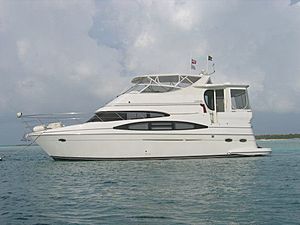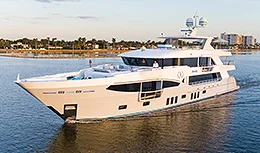- Alaskan Yachts
- Azimut Yachts
- Back Cove Yachts
- Beneteau Yachts
- Benetti Superyachts
- Bertram Yachts
- Boston Whaler
- Broward Yachts
- Buddy Davis Sportfish
- Burger Yachts
- Cabo Yachts
- Catamarans
- Carver Motoryachts
- Center Console
- Chris-Craft Yachts
- Cruisers Yachts
- DeFever Trawlers
- Dufour Sailboats
- Fairline Yachts
- Feadship Yachts
- Ferretti Yachts
- Filippetti Yachts
- Formula Yachts
- Fountaine Pajot Cats
- Grady-White
- Grand Banks Trawlers
- Hargrave Yachts
- Hatteras Yachts
- Hinckley Picnic Boats
- Horizon Yachts
- Hydra-Sports
- Intrepid Boats
- Jarrett Bay Sportfish
- Jeanneau Yachts
- Kadey-Krogen Trawlers
- Lazzara Yachts
- Lekker Boats
- Luhrs Sportfish
- Marlow Yachts
- Maritimo Yachts
- Marquis Yachts
- Mazu Yachts
- McKinna Motoryachts
- Meridian Yachts
- Midnight Express
- MJM Yachts
- Mochi Craft
- Neptunus Motoryachts
- Nordhavn Trawlers
- Nordic Tugs
- Numarine Yachts
- Ocean Alexander Yachts
- Ocean King
- Offshore Yachts
- Outer Reef
- Oyster Sailing Yachts
- Pacific Mariner Yachts
- Palmer Johnson Yachts
466 Carver
![]()

Source: Capt. Bill Pike, Power & Motoryacht Magazine
My first years of commercial seafaring were spent sailing the Great Lakes on ore carriers. After hitting all sorts of ports for a couple of years, from the taconite docks of Duluth to the grain wharves of Sept Iles, I was constrained to conclude that Midwestern cities and towns were alike in at least one respect: They were invariably jam-packed with highly skilled people, most possessing a work ethic that would put Puritans to shame. Whether one of the ships I was working on needed new stanchions welded in Saginaw or radar repairs in Superior, it seemed there were always plenty of shoreside folks around who could do the work, do it fast, and do it well.
Carver Yachts is a Midwestern firm, of course. So I guess I shouldn’t have been that surprised when, prior to a recent sea trial of the company’s new 466 Motor Yacht in Sturgeon Bay, a visit to nearby Pulaski, Wisconsin, and the plant where the boat is built, engendered a heartwarming dose of déja vu. The enthusiasm, expertise, and commitment to quality I encountered among the Carver employees was every bit as compelling as anything I’d seen on or near the lakes years before.
The Wire Shop was a prime example. About the size of a small house and smartly staffed with 17 men and women of varying ages, the place felt charged with can-do enthusiasm and expertise. It was as if you could drop virtually any kind of design or engineering problem on these folks and they’d come up with an answer—fast.
Organization was an obvious priority. Up front were large, meticulously installed and maintained terminal-crimping machines, which Carver uses to obviate the unevenness and unreliability of terminals hand-crimped on an assembly line. In the back, similarly well-cared-for injection-molding devices held sway, deftly turning out beefy, pin-type harness connectors; Carver says they stand up to corrosion and other problems better than cheaper, looser products. And just about everywhere else in the place, amid stools, toolboxes, and long workbenches laden with everything from humidity-resistant magnetic breaker switches to heavy coils of corrosion-resistant, tinned-copper wire, stood huge (8’x16′) “harness assembly boards.” Embellished with giant, blueprint-like templates punctuated by hooks, brackets, and other fitments, these babies serve as giant jigs for the modular electrical harnesses that Carver substitutes for more glitch-prone piecemeal wiring.
The other spot I found especially indicative of the Midwestern work ethic during my tour was the Wood Shop. Staffed with 85 people divided among three shifts, it had just about the same can-do, red-white-and-blue atmosphere as the Wire Shop. While most of the machine operators I met here had worked for Carver for at least a couple of decades, I ran into one guy who was finishing off his 32nd year. With obvious pride he showed me several cherry-wood door- and door-frame assemblies destined for 466s. The craftsmanship was superb, with doweled joints, countersunk and smoothly bunged-over stainless steel fasteners, and elegantly chamfered fascia and other surfaces.
Later that afternoon I sea-trialed a 466 on Green Bay’s Fox River, where near-smooth conditions precluded any rough-water tests. Performance was lively, with an average top speed of 29.6 mph, a smooth, moderate bank in turns, and an optimum, three- to four-degree running attitude on plane with just a little tab necessary above 2500 rpm. The layout of the automotive-style dash was a savvy one, having a central pod with big Beede gauges on top, just below the Ritchie compass and rocker switches for deck equipment beneath. I liked the way the gauges were prioritized, with a rudder-angle indicator and synchronizer dead center, tachs on either side, and multifunction dials all the way outboard.
Underway, visibility forward from the bridge’s centerline helm seat was excellent, and thanks to a set of sweet, single-stick Volvo Penta electronic controls, an optional QL 10-hp bow thruster, and some decent visibility aft via a large opening under the hardtop, docking the vessel, whether alongside or stern-to, was easy. Moreover, the ride was stalwart, thanks to a robust, all-glass hull bottom (with Knytex substrates and a vinylester barrier coat), hull sides, decks, and superstructure cored with Divinycell and/or Baltek-AL-600/10, a hull-to-deck joint bonded with screws and polyurethane sealant, and aluminum truss reinforcements around the frameless cabin windows.
My dockside examination of the 466 after the test-drive confirmed what I already knew: Carver’s forte is luxury and lots of room to enjoy it. The interior layout pays homage to a floorplan that’s done good service for years: a VIP stateroom forward, master aft, and saloon/galley-down between. The goodies Carver manages to discretely merge into this expansive scheme are truly astounding.
Take the master. In addition to a raft of aircraft-type cabinets overhead, two voluminous cedar-lined hanging lockers, alcove bookcases, two integral cherry dressers with Karadon countertops, and oodles of drawer space, our test boat had a queen-size berth with innerspring mattress that lifts electrically to reveal stowage. In addition, there’s a large ensuite head with a separate, also-large stall shower, L-shape Karadon counters, and a deep, user-friendly stainless steel sink.
The saloon was equally replete. Anytime you combine a pair of Flexsteel incliner-equipped UltraLeather settees (port and starboard), with a top-shelf, built-in entertainment center (JVC TV and VCR, Harmon-Kardon AM/FM stereo/CD player, Kenwood CD changer, and Bose speakers), you’re dealing with ItotalI kick-back relaxation.
A look around the machinery spaces of the 466 took me back to what I’d seen earlier on the assembly line in Pulaski. The engine room, accessed through a hatch in the saloon sole, is gelcoated white and efficiently lit with fluorescent lights. An integrated lattice of aluminum box beams supports the weight of the sole and other componentry above. Massive, double-gusseted engine mounts are bolted through all-glass, hat-section engine bearers, with cutouts outboard for easy access. Farther astern in a lazarette accessed through hatches concealed in the master stateroom cabinetry, I examined rudder stocks actuated via indestructible-looking tiller arms of graphite composite, mounted on a beefy rudder shelf and centered in the same kind of Tides Marine dripless shaft logs as the prop shafts.
I finished up the 466 with a topside tour. While I liked the shippy appearance of the big windlass at the bow—an option from Maxwell—and the extra safety of wide side decks with thigh-high bowrails and stanchion bases welded inside and out for maximum strength, what really rang my bell was a small yet significant detail: The cleats on deck are massive—12 inches horn to horn—and run through with four big bolts and secured with thick aluminum backing plates, fender washers, and aviation-style nuts with nylon bushings. PA good job? More like a Great Lakes job, I’d say.
Boat Specification: 466 Carver
LOA: 46’11”
Beam: 14’11”
Draft: 3’61/2″
Weight: 37,000 lbs.
Fuel capacity: 480 gal.
Water capacity: 130 gal.
Test engines: 2/480-hp Volvo Penta TAMD74P EDC diesel inboards
Transmission: ZF 280A
Ratio: 2.23:1
Props: 28×32 Teignbridge 4-blade Aquaskew
Steering: Teleflex hydraulic
Controls: Volvo Penta electronic
Optional equipment on test boat: 10-hp QL bow thruster; Maxwell 1200 Lo Profile windlass; X-Changer oil-change system; 54,000-BTU Marine Air A/C; 8-kW Kohler genset; Glendinning Cablemaster; VacuFlush MSDs; washer/dryer; central vacuum



